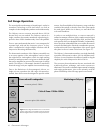
Placement 9
Imaging
In their final location, your Odysseys should have a stage
width somewhat wider than the speakers themselves. On
well recorded music, the instruments should extend beyond
the edges of each speaker to the left and to the right, yet a
vocalist should appear directly in the middle. The size of
the instruments should be neither too large nor too small.
Additionally, you should find good clues as to stage depth.
Make sure that the vertical alignment, distance from the
front wall, and toe-in, is exactly the same from one speaker to
the other. This greatly enhances the quality of your imaging.
Bass Response
Your bass response should neither be one note nor should
it be too heavy. It should extend to even the deepest organ
passages, yet it should be tight and well defined. Kick-drums
should be tight and percussive—string bass notes should
be uniform and consistent throughout the entirety of the
run without any booming or thudding.
In order to reduce these effects and allow for more flexibility
in positioning, the Odyssey implements a bass control system
derived from the revolutionary Prodigy ForceForward
TM
control system. This innovative technology controls the
first reflective bass energy from the front wall—minimizing
the typical 50Hz suck-out for smooth, powerful bass at the
listening position.
Tonal Balance
Voices should be natural and full, cymbals should be
detailed and articulate yet not bright and piercing, pianos
should have a nice transient characteristic and deep tonal
registers as well. If you cannot attain these virtues, read the
section on Room Acoustics (pages 12–13). This will give
you clues on how to get closer to those ideal virtues.
Final Placement
After obtaining good wall treatments and attaining proper
angle, begin to experiment with the distance from the wall
behind the speakers. Move your speaker slightly forward
into the room. What happened to the bass response?
What happened to the imaging? If the imaging is more
open and spacious and the bass response is tightened, that
is a superior position. Move the speakers back six inches
from the initial setup position and again listen to the imaging
and bass response. There will be a position where you will
have pinpoint imaging and good bass response. That position
is the point of the optimal placement from the front wall.
Now experiment with placing the speakers farther apart.
As the speakers are positioned farther apart, listen again,
not so much for bass response but for stage width and
good pinpoint focusing. Your ideal listening position
and speaker position will be determined by:
•Tightness and extension of bass response
•Width of the stage
•Pinpoint focusing of imaging
Once you have determined the best of all three of these
considerations, you will have your best speaker location.
The Extra “Tweak”
As a final test of exact placement, use these measurements
for your speakers placement, and see what can happen to
the ultimate enhancement of your system’s performance.
These two basic formulas will determine optimum placement
of your speakers to minimize standing waves.
1. Distance from the front wall (the wall in front of the listening
position) to the center of the curvilinear transducer. To
determine distance from the front wall, measure the height
of your ceiling (inches) and multiply the figure by 0.618
(i.e. ceiling height in inches x 0.618 = the distance from
the front wall to the center of the curvilinear transducer).
2. Distance from the side-walls to the center of the curvilinear
transducer. To determine distance from the side walls,
measure the width of your room in inches and divide
by 18. Next, multiply the quotient by 5 (i.e. room width
in inches/18] x 5 = the distance from the side-walls to
the center of the curvilinear transducer).
Enjoy Yourself
The Odyssey is a very refined speaker and benefits from
care in setup. With these tips in mind you will find, over
your months of listening, that small changes can result in
measurable differences. As you live with your speakers, do
not be afraid to experiment with their positioning until
you find the optimal relationship between your room and
speaker system that gives to you the best results. Your efforts
will be rewarded.


















